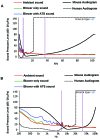Noise in a laboratory animal facility from the human and mouse perspectives
- PMID: 20858361
- PMCID: PMC2949429
Noise in a laboratory animal facility from the human and mouse perspectives
Abstract
The current study was performed to understand the level of sound produced by ventilated racks, animal transfer stations, and construction equipment that mice in ventilated cages hear relative to what humans would hear in the same environment. Although the ventilated rack and animal transfer station both produced sound pressure levels above the ambient level within the human hearing range, the sound pressure levels within the mouse hearing range did not increase above ambient noise from either noise source. When various types of construction equipment were used 3 ft from the ventilated rack, the sound pressure level within the mouse hearing range was increased but to a lesser degree for each implement than were the sound pressure levels within the human hearing range. At more distant locations within the animal facility, sound pressure levels from the large jackhammer within the mouse hearing range decreased much more rapidly than did those in the human hearing range, indicating that less of the sound is perceived by mice than by humans. The relatively high proportion of low-frequency sound produced by the shot blaster, used without the metal shot that it normally uses to clean concrete, increased the sound pressure level above the ambient level for humans but did not increase sound pressure levels above ambient noise for mice at locations greater than 3 ft from inside of the cage, where sound was measured. This study demonstrates that sound clearly audible to humans in the animal facility may be perceived to a lesser degree or not at all by mice, because of the frequency content of the sound.
Figures






References
-
- Anthony A, Harclerode JE. 1959. Noise stress in laboratory rodents. II. Effects of chronic noise exposures on sexual performance and reproductive function of guinea pigs. J Acoust Soc Am 31:1437–1440
-
- Buckley JP, Smooker HH. 1970. Cardiovascular and biochemical effects of chronic intermittent neurogenic stimulation, p 85–74 : Welch BL, Welch AS. Physiological effects of noise. New York (NY): Plenum Press
-
- Center for Hearing and Communication [Internet] Facts on noise. [Cited 17 Sep 2009]. Available at: www.lhh.org/noise/facts/evironment.html
-
- Dallman MF, Akana SF, Bell ME, Bhatnagar S, Choi S, Chu A, Gomez F, Laugero K, Soriano L, Viau V. 1999. Warning! Nearby construction can profoundly affect your experiments. Endocrine 11:111–113 - PubMed
-
- Dallman MF, Akana SF, Bradbury MJ, Strack AM, Hanson ES, Scribner KA. 1994. Regulation of the hypothalamo-pituitary-adrenal axis during stress: feedback, facilitation, and feeding. Seminars in Neuroscience 6:205–213
MeSH terms
LinkOut - more resources
Full Text Sources
Other Literature Sources
Medical
